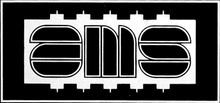Founded 1976, United Kingdom | Headquarters Burnley, United Kingdom | |
 | ||
Industry Professional audio design & engineering Key people Mark Crabtree
Stuart Nevison Products Audio & recording equipment Founders Stuart Nevison, Mark Crabtree | ||
Introduction to the neve genesys black part 1
AMS (Advanced Music Systems) were a manufacturer of professional studio equipment. The company later merged with Neve Electronics to form the award winning AMS Neve Ltd company, who received an Emmy in 1992 and a Grammy in 2000.
Contents
Background
AMS (Advanced Music Systems) were established in 1976 by Mark Crabtree and Stuart Nevison. They had been Aerospace engineers moving into the design of professional studio equipment for the manipulation and control of sound. The first product designed by the company was the DM-20 Tape Phase Simulator. This initial product was notably used by ELO, 10cc and Paul McCartney, who used it on the Wings' London Town album in 1978. In 1978 AMS introduced the world's first microprocessor controlled, 15 bit digital delay line - the AMS DMX 15-80.One of the early users of the AMS DMX 15-80 was Manchester record producer Martin Hannett who would go on to own quite a few of the devices. Later the DMX included "loop triggering" launching the use of digital sampling. The DMX later included pitch changing and up to 32 seconds of delay.
In 1981 AMS released the RMX-16 digital reverberator. This new effects processor's "Non Lin 2"-setting was digitally emulating the drum sound (of compressing and gating a room microphone) that was used on the Phil Collins recording In the Air Tonight. The track's unique drum sound was created by a combination of a room microphone compressed by the "Listen Mic"-Compressor of an early SSL Console in combination with cutting off the reverb sound with a noise gate. AMS then released the Audiofile, one of the first 16-bit hard disk based recording systems dedicated to Post production. In 1988, the company released the Logic 1; it was the first dynamically configurable, fully automated digital mixing console. In 1992, AMS merged with Neve and carried on manufacturing professional recording equipment.
